Best Voice Recognition Software
Best voice recognition software platforms that one can use in 2024 are lilyspeech, express scribe, trint, brain, augnito, dialics, and onevoicedata.



No Cost Personal Advisor
List of 20 Best Voice Recognition Software
Contenders | 2024
Software by CallRail Inc.
CallRail call tracking software provides call analytics to data driven marketers so they can improve customer acquisition. Delivering intuitive self-service software to businesses that care about phone calls, CallRail enables smart marketers to know what makes their phone ring. Read CallRail Reviews
Explore various CallRail features, compare the pricing plans, and unlock the potential of seamless operations by selecting the right software for your business.
Features
View all CallRail Features- On-Demand Recording
- Keyword Tracking
- Conversion Tracking
- Lead Capture
- Call Routing
- Voicemail Transcription
- File Transfer
- Archiving
Pricing
CallRail Caters to
- StartUps
- SMBs
- Agencies
- Enterprises
Contenders | 2024
Software by OpenPhone Technologies Inc
OpenPhone is a fully-featured business phone software designed to serve SMEs, startups, Agencies, and Enterprises. OpenPhone provides end-to-end solutions designed for Web apps. This Business Phone System offers Call Monitoring, Mobile Access, Call Recording, Call Management, and IVR / Voice Recognition in one place. Read OpenPhone Reviews
Explore various OpenPhone features, compare the pricing plans, and unlock the potential of seamless operations by selecting the right software for your business.
Features
View all OpenPhone Features- CRM integration
- Contact Management
- Chat / Messaging
- Mobile Access
- Call Logging
- SMS Messaging
- Business Phone Number
- Call Routing
Pricing
OpenPhone Caters to
- StartUps
- SMBs
- Agencies
- Enterprises
Contenders | 2024
Software by Otter.ai
Otter is a fully featured Productivity Management Software designed to serve SMEs, Startup, Agencies, Enterprises. Otter provides end-to-end solutions designed for Web App. This Productivity Management System offers File Sharing, Speech Recognition, AI/Machine Learning, Subtitles/Closed Captions, Natural Language Processing at one place. Read Otter Reviews
Explore various Otter features, compare the pricing plans, and unlock the potential of seamless operations by selecting the right software for your business.
Features
View all Otter Features- AI/Machine Learning
- File Sharing
- Automatic Transcription
- Subtitles/Closed Captions
- Full Text Search
- Audio/video File Upload
- Collaboration Tools
- Text Editing
Pricing
Basic
$ 0
Per Month
Pro
$ 17
Per Month
Business
$ 30
Per Month
Otter Caters to
- StartUps
- SMBs
- Agencies
- Enterprises
Contenders | 2024
Software by Brainasoft
Braina is one of the best AI software solutions that support multiple languages and serves as a virtual voice recognition software for Windows PC. Using this software, users can convert speech to text at a rapid pace. Artificial intelligence software supports more than 100 languages and helps make tasks easier. Read Braina Reviews
Explore various Braina features, compare the pricing plans, and unlock the potential of seamless operations by selecting the right software for your business.
Braina Caters to
- StartUps
- SMBs
- Agencies
- Enterprises
Emergents | 2024
Free Voice To Text Speech Recognition Dictation So
Lilyspeech let you type with your voice anywhere in windows. LilySpeech the only high functioning free voice to text speech recognition dictation software for windows. It works with all applications in windows allowing you to type anywhere with your voice. Read LilySpeech Reviews
Explore various LilySpeech features, compare the pricing plans, and unlock the potential of seamless operations by selecting the right software for your business.
Features
View all LilySpeech Features- Text to Speech
- Speech-to-Text Analysis
- Multi-Language
- Voice Recognition
- Social Sharing
Pricing
Free
$ 0
Lifetime License
Premium
$ 29
Lifetime License
LilySpeech Caters to
- StartUps
- SMBs
- Agencies
- Enterprises
Contenders | 2024
Pay Per Call Tracking Software
Dialics is a cloud-based inbound call tracking software for professional Pay Per Call Marketers. It helps businesses to manage call attributions, recording and routing and helps measure campaigns performance and make better marketing decisions. Read Dialics Reviews
Explore various Dialics features, compare the pricing plans, and unlock the potential of seamless operations by selecting the right software for your business.
Features
View all Dialics Features- IVR / Voice Recognition
- Call Routing
- Analytics
- Call Center Management
- Call Recording
- Call Reporting
Pricing
Monthly Plan
$ 99
Per Month
Dialics Caters to
- StartUps
- SMBs
- Agencies
- Enterprises
Contenders | 2024
Making life easy for physicians
Making a physician's life easy by completely removing the EHR documentation burden and EHR navigation challenges, the physician is able to see more patients and spend quality time with the patients.. Read S10.AI Reviews
Explore various S10.AI features, compare the pricing plans, and unlock the potential of seamless operations by selecting the right software for your business.
Features
View all S10.AI Features- Customizable Macros
- Audio Transmission
- Audio File Management
- Abbreviation Expansion
- Text Editing
- Automatic Transcription Services
- Annotations
- Voice Recognition
Pricing
S10 Robot EHR voice dictation
$ 350
Per Month
S10 Robot medical transcribe
$ 500
Per Month
S10 robot medical converscribe
$ 950
Per Month
S10.AI Caters to
- StartUps
- SMBs
- Agencies
- Enterprises
Contenders | 2024
Innovative Speech To Text Transcription solution,
Rythmex is a cutting-edge transcription solution designed to revolutionize the way businesses could automatically recognize speech and transcribe audio & video recordings. Read Rythmex Reviews
Explore various Rythmex features, compare the pricing plans, and unlock the potential of seamless operations by selecting the right software for your business.
Features
View all Rythmex Features- Subtitles/Closed Captions
- Natural Language Processing
- Audio File Management
- Timecoding
- Automatic Transcription
- Text Editing
- Speech Recognition
- Full Text Search
Pricing
Basic
$ 15
Per Month
Premium
$ 25
Per Month
Premium Yearly
$ 199
Per Year
Rythmex Caters to
- StartUps
- SMBs
- Agencies
- Enterprises
Contenders | 2024
Software by Zuzis
VoiceboxMD is a fully featured Speech Recognition Software designed to serve Agencies, Startups. VoiceboxMD provides end-to-end solutions designed for Macintosh. This online Speech Recognition system offers Customizable Macros, Automatic Transcription, Archiving & Retention, Abbreviation Expansion, Voice Recognition at one place. Read VoiceboxMD Reviews
Explore various VoiceboxMD features, compare the pricing plans, and unlock the potential of seamless operations by selecting the right software for your business.
Features
View all VoiceboxMD Features- Customizable Macros
- Automatic Transcription
- Abbreviation Expansion
- Voice Recognition
- Audio Capture
- Audio File Management
- Archiving & Retention
- Audio Transmission
VoiceboxMD Caters to
- StartUps
- SMBs
- Agencies
- Enterprises
Emergents | 2024
Software by Scribetech Healthcare Pvt. Ltd
Augnito is a fully featured Voice Recognition software designed to serve SMEs, Startup, Agencies, Enterprises. Augnito provides end-to-end solutions designed for Web App. Learn more about Augnito
Explore various Augnito features, compare the pricing plans, and unlock the potential of seamless operations by selecting the right software for your business.
Augnito Caters to
- StartUps
- SMBs
- Agencies
- Enterprises
Emergents | 2024
Software by NCH Software, Inc
Express Scribe is medical transcription software that helps you share the data files easily, work with word editor, can dock analog and digital portable voice recorders, and can play audios of various format easily. Compatible with Windows and Mac OS X Learn more about Express Scribe
Explore various Express Scribe features, compare the pricing plans, and unlock the potential of seamless operations by selecting the right software for your business.
Features
View all Express Scribe Features- Archiving & Retention
- Audio File Management
- Audio Transmission
- Transcription Reporting
- Voice Recognition
- Abbreviation Expansion
- Voice Capture
Pricing
Professional
$ 70
One Time
Express Scribe Caters to
- StartUps
- SMBs
- Agencies
- Enterprises
Emergents | 2024
Software by Ebby
Ebby is a fully featured Speech Recognition Software designed to serve Enterprises, SMEs and StartUps. Ebby provides end-to-end solutions designed for Web App and Android. This online Speech Recognition system offers Voice Recognition, Multi-Language and Automatic Transcription at one place. Learn more about Ebby
Explore various Ebby features, compare the pricing plans, and unlock the potential of seamless operations by selecting the right software for your business.
Features
View all Ebby Features- Supports HD Resolution
- Audio File Management
- Transcription Reporting
- Survey Management
- Automatic Transcription
- Audio Capture
- Multi-Language
- Voice Recognition
Ebby Caters to
- StartUps
- SMBs
- Agencies
- Enterprises
Emergents | 2024
Software by Verbio Technologies
Verbio Speech Recognition is a fully featured Speech Recognition Software designed to serve Enterprises, SMEs and StartUps. Verbio Speech Recognition provides end-to-end solutions designed for Web App and Android. This online Speech Recognition system offers Voice Recognition, Multi-Language, Speech-to-Text Analysis, Audio Capture, Automatic Transcription and Concatenated Speech at one place. Learn more about Verbio Speech Recognition
Explore various Verbio Speech Recognition features, compare the pricing plans, and unlock the potential of seamless operations by selecting the right software for your business.
- Concatenated Speech
- Voice Recognition
- Multi-Language
- Audio Capture
- Automatic Transcription
- Speech-to-Text Analysis
Verbio Speech Recognition Caters to
- StartUps
- SMBs
- Agencies
- Enterprises
Emergents | 2024
Software by Trint
Trint is a fully featured Speech Recognition Software designed to serve Agencies, SMEs. Trint provides end-to-end solutions designed for Windows. This online Speech Recognition system offers Audio Capture, Automatic Transcription, Multi-Language, Voice Recognition at one place. Learn more about Trint
Explore various Trint features, compare the pricing plans, and unlock the potential of seamless operations by selecting the right software for your business.
Features
View all Trint Features- Automatic Transcription
- Audio Capture
- Voice Customization
- Multi-Language
- Speech-to-Text Analysis
- Voice Recognition
- Transcription Reporting
- Call Recording
Trint Caters to
- StartUps
- SMBs
- Agencies
- Enterprises
Emergents | 2024
text to speech software, text to speech converter,
Naturaltts is a freemium text to speech converter that allows clients to convert any type of text into the real human speech. For now, it has more than 27 languages to choose from as well as 61+ premium natural-sounding voices. Learn more about Naturaltts
Explore various Naturaltts features, compare the pricing plans, and unlock the potential of seamless operations by selecting the right software for your business.
Features
View all Naturaltts Features- Audio Tools
- Voice Recognition
- Text to Speech
- Audio File Management
- Concatenated Speech
- Voice Customization
- Call Center
Pricing
Free
$ 0
Monthly Subscription
Personal
$ 9
Monthly Subscription
Commercial
$ 79
Monthly Subscription
Naturaltts Caters to
- StartUps
- SMBs
- Agencies
- Enterprises
Emergents | 2024
Software by Sonix
Sonix is a fully featured Speech Recognition Software designed to serve SMEs, Agencies. Sonix provides end-to-end solutions designed for Web App. This online Speech Recognition system offers Multi-Language, Speech-to-Text Analysis, Voice Recognition, Audio File Management, Voice Recognition at one place. Learn more about Sonix
Explore various Sonix features, compare the pricing plans, and unlock the potential of seamless operations by selecting the right software for your business.
Features
View all Sonix Features- Voice Recognition
- Concatenated Speech
- Transcription Reporting
- Audio File Management
- Text to Speech
- Survey Management
- Speech-to-Text Analysis
- Multi-Language
Sonix Caters to
- StartUps
- SMBs
- Agencies
- Enterprises
Emergents | 2024
In-built 100% focus on voice biometrics
Designed for developers, VoiceVault Fusion has fully configured dictation software that can create mobile apps with voice biometrics library. The software has in-built English phrase and digits support. Learn more about VoiceVault Fusion
Explore various VoiceVault Fusion features, compare the pricing plans, and unlock the potential of seamless operations by selecting the right software for your business.
Features
View all VoiceVault Fusion Features- Call Center
- Audio Capture
- Multiple Scripts
- Voice Recognition
- Call Recording
- Phone Key Input
- Voice Customization
VoiceVault Fusion Caters to
- StartUps
- SMBs
- Agencies
- Enterprises
Emergents | 2024
Speed up your typing using Whisper voice recogniti
SpeechPulse is an offline voice-to-text application for Windows 10 and 11. It can type in any text input area, such as text editors, web browsers, and office apps. SpeechPulse can also create subtitles for audio and video files with custom subtitle widths. Learn more about SpeechPulse
Explore various SpeechPulse features, compare the pricing plans, and unlock the potential of seamless operations by selecting the right software for your business.
Features
View all SpeechPulse Features- Speaker Verification
- Speech-to-Text Analysis
- AI/Machine Learning
- Automatic Speech Recognition
- Language Model Customization
- Multi-Language
- Speech-to-Text Conversion
- Command and Control Capabilities
Pricing
SpeechPulse
$ 20
Full License/Single User
SpeechPulse Caters to
- StartUps
- SMBs
- Agencies
- Enterprises
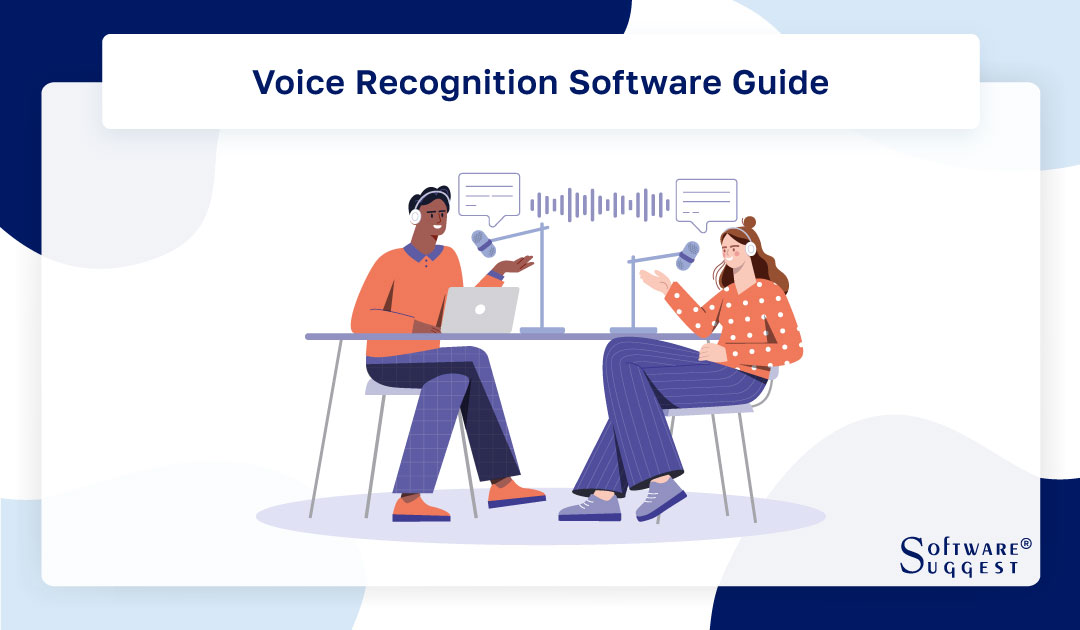
Voice Recognition Software has revolutionized how we interact with technology, providing seamless and natural communication between humans and computers. This remarkable technology enables devices and applications to understand spoken language, converting it into written text or executing commands, making it a powerful tool in various industries and daily life.
With continuous advancements in Artificial Intelligence and Natural Language Processing, Voice Recognition Software has become increasingly accurate and context-aware, opening up a myriad of possibilities for hands-free operations, accessibility, and enhanced user experiences. In this digital age, Voice Recognition solutions stand at the forefront of human-computer interfaces, shaping the future of technology and communication.
What Is Voice Recognition Software?
Voice Recognition Software, also known as Speech Recognition Software, is an advanced technology that enables computers and digital devices to understand and interpret human speech. This software employs sophisticated algorithms and artificial intelligence to convert spoken language into written text or to perform various tasks based on voice commands.
The process begins with capturing audio input through a microphone, which is then processed by the software to identify patterns, phonemes, and linguistic structures. Through continuous learning and improvement, voice recognition software can adapt to different accents, languages, and speaking styles, enhancing its accuracy over time.
Types of Voice Recognition Software
Voice Recognition Software is a powerful technology that enables computers and digital devices to understand and interpret human speech. It has diverse applications, from virtual assistants to transcription services, making it an essential tool in various industries.
Within the realm of Voice Recognition Software, several distinct types are tailored to different use cases and user preferences. Let's explore each type in detail:
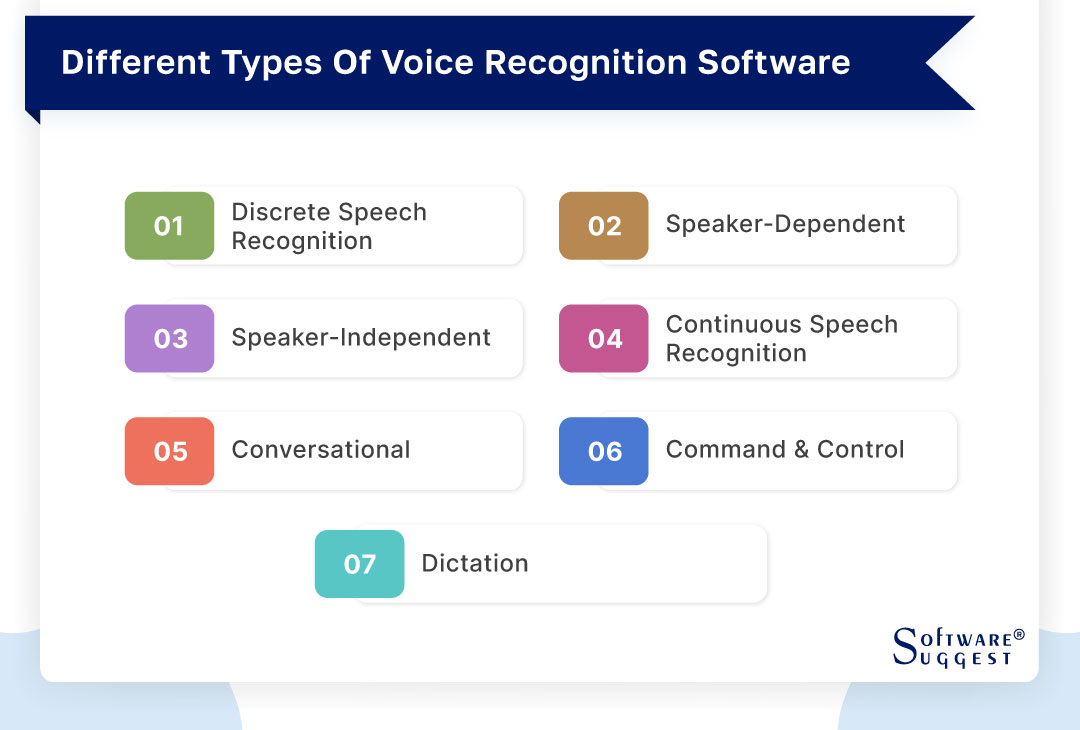
-
Discrete Speech Recognition
Discrete speech recognition involves processing speech input in short segments or discrete units, such as individual words or short phrases. It is commonly used in applications where users pause between words or phrases, allowing the software to recognize and process speech more accurately. Discrete speech recognition is particularly useful for tasks like voice-controlled dialing, menu navigation, and simple command execution.
-
Speaker-Dependent
Speaker-dependent voice recognition software is trained to recognize the voice of a specific individual or user. Before usage, the system requires the user to provide a training set of their spoken words, allowing the software to learn and adapt to the unique characteristics of that person's voice. As a result, speaker-dependent systems offer higher accuracy and reduced error rates for the trained user, but they might not perform as well with other speakers.
-
Speaker-Independent
In contrast to speaker-dependent systems, speaker-independent voice recognition software does not require individual user training. These systems are designed to recognize and interpret the speech of any user, regardless of their voice characteristics. While speaker-independent systems are more versatile and can handle multiple users, they may have slightly lower accuracy compared to speaker-dependent systems.
-
Continuous Speech Recognition
Continuous speech recognition technology allows users to speak naturally without having to pause between words or phrases. The software continuously processes the audio input, capturing the entire speech stream and converting it into written text or performing tasks based on the user's commands. Continuous speech recognition is commonly used in voice assistants like Siri or Google Assistant, enabling fluid and conversational interactions with the software.
-
Conversational
Conversational voice recognition software is designed to understand and respond to natural language conversations. It goes beyond simple command recognition and aims to provide context-aware responses, facilitating more human-like interactions between users and machines. This type of software is often used in chatbots, customer service applications, and interactive virtual agents.
-
Command and Control
Command and control voice recognition software is optimized for recognizing specific, predefined voice commands. It excels at executing tasks based on short, concise instructions. This type of software is commonly used in smart home devices, voice control appliances, and various hands-free systems.
-
Dictation
Dictation voice recognition software is focused on accurately transcribing spoken words into written text. It is commonly used by professionals such as writers, journalists, and office workers who benefit from hands-free document creation. Dictation software is designed to handle longer and more complex sentences while maintaining high accuracy in transcription.
Who Are The Users of the Voice Recognition Program?
Voice Recognition Programs have gained widespread popularity and integration across various industries because they enhance efficiency, accessibility, and user experiences. Let's explore the different user groups that benefit from Voice Recognition Programs and how this technology serves their specific needs.

-
Healthcare Providers
Healthcare professionals, including doctors, nurses, and medical practitioners, find great utility in Voice Recognition Programs. These tools enable them to efficiently dictate patient notes, medical records, and prescriptions. Voice recognition streamlines documentation processes, allowing healthcare providers to focus more on patient care while ensuring accurate and comprehensive records.
-
Disability Services
Voice Recognition Programs have been a game-changer for individuals with physical disabilities or limited mobility. For those with difficulty using traditional input methods like keyboards or mice, voice recognition is an essential tool to access computers and perform tasks independently. It empowers differently-abled individuals to communicate, browse the web, and engage with technology more effectively.
-
Law Enforcement & Legal Professionals
Law enforcement officers and legal professionals heavily rely on Voice Recognition Programs for transcription, note-taking, and documentation during investigations, interviews, and courtroom proceedings. This technology expedites creating official records and maintaining accurate documentation, which is crucial for legal proceedings.
-
Customer Support
Voice Recognition Programs are increasingly used in customer support and call centers to streamline interactions between customers and service representatives. They enhance call routing and automate certain processes, allowing customers to quickly access the information they need or perform certain tasks without waiting for an agent.
-
Automotive
Voice Recognition Programs play a vital role in modern vehicles, enabling drivers to control various functions hands-free. By using voice commands, drivers can control infotainment systems, navigation, make calls, and send messages while keeping their focus on the road, thus enhancing safety and driving convenience.
-
Technology
Technology professionals, including software developers, system administrators, and IT support staff, use speech recognition algorithms to dictate code, write technical documentation, and perform tasks more efficiently. Voice recognition helps reduce Google Docs voice typing time and increases productivity for tech industry workers.
-
Sales
Sales professionals often have busy schedules and are frequently on the move. Speaker recognition software enable them to manage their schedules, send emails, and update customer information through voice commands, allowing them to stay organized and responsive while being hands-free.
Benefits of using the Best Voice Recognition Software
As technology advances, the benefits of using the best voice recognition software become increasingly apparent across various industries and user scenarios. Below are the advantages of voice recognition software.
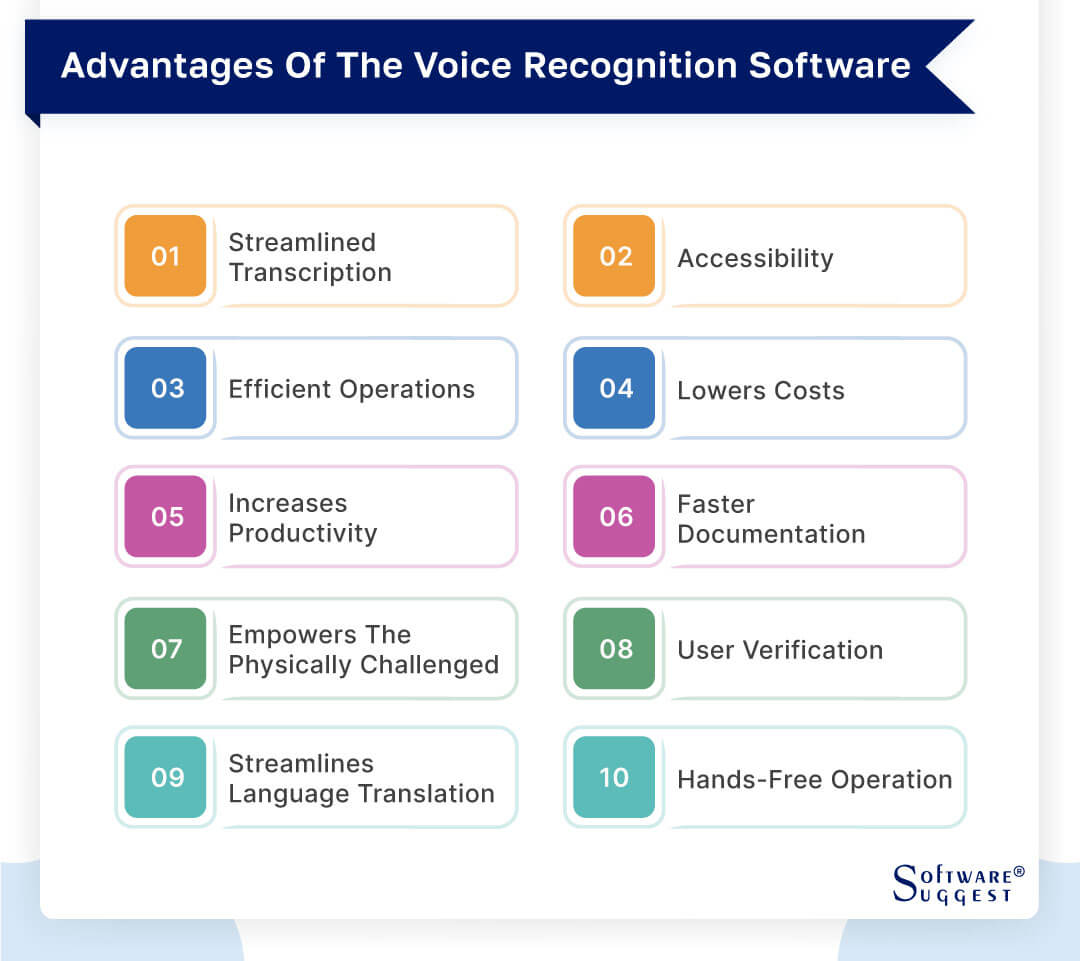
-
Streamlined Transcription
The best voice recognition software significantly simplifies the transcription process, accurately converting spoken words into text. Users can dictate their thoughts, ideas, or notes directly, eliminating the need for manual typing or writing. This streamlining of transcription saves time and effort, making it a valuable tool for professionals in fields like journalism, medicine, and legal services.
-
Accessibility
Voice recognition software enhances accessibility for individuals with physical disabilities or conditions that hinder traditional typing. People with mobility impairments or those who have difficulty using keyboards can now interact with technology effortlessly by speaking commands or inputting text using their voice, promoting inclusivity in the digital world.
-
Efficient Operations
By reducing the reliance on manual data entry and typing, voice recognition software streamlines various operations, from data collection to administrative tasks. Employees can focus on more value-added activities, resulting in improved overall efficiency and task completion.
-
Lowers Costs
Voice matching software can contribute to cost savings in organizations by reducing the need for hiring transcription services or additional administrative support. With more streamlined processes, companies can allocate resources more effectively and potentially scale their operations efficiently.
-
Increases Productivity
The ease and speed of using AI voice recognition software enhance productivity levels. Users can complete tasks more rapidly, such as composing emails, creating documents, or conducting research, freeing up time for other important activities.
-
Faster Documentation
Professionals in various fields can benefit from the ability to create documentation using software for voice recognition quickly. For example, doctors can dictate patient notes directly into electronic health records, saving time and ensuring accurate and up-to-date documentation.
-
Empowers the Physically Challenged
Voice recognition software empowers individuals with physical disabilities or conditions like repetitive strain injuries to engage with technology effectively. It reduces physical strain, enabling users to accomplish tasks without causing discomfort or exacerbating their condition.
-
User Verification
Voice recognition software can be used for user verification and authentication. Biometric voice authentication adds an extra layer of security to access sensitive information or perform critical actions, making it difficult for unauthorized individuals to gain access.
-
Streamlines Language Translation
Voice recognition software with language translation capabilities facilitates seamless communication between individuals who speak different languages. Users can speak in their native language, and the software translates their speech in real-time, promoting effective global communication and collaboration.
-
Hands-Free Operation
The hands-free nature of voice recognition software is particularly beneficial in environments where manual input is challenging or unsafe, such as while driving or operating machinery. Users can perform tasks or access information without taking their hands off the wheel or their primary tasks.
Key Features of the Best Voice Recognition Tools
The Best Voice Recognition Tools are equipped with a range of key features that harness the power of Artificial Intelligence (AI) and Machine Learning (ML) to interpret human speech and perform various tasks accurately. Let's explore the key features that make these Voice recognition tools stand out -

-
AI and ML Model Training
AI and ML Model Training is a key feature of the Best Voice Recognition Tools, contributing to their high accuracy and adaptability. It involves the use of Artificial Intelligence (AI) and Machine Learning (ML) techniques to continuously improve the software's ability to recognize and interpret human speech. During training, the software is exposed to vast amounts of diverse speech data, allowing it to learn and identify patterns, phonemes, and linguistic structures.
-
Audio Capture
Audio Capture is a fundamental and crucial feature of the Best Voice Recognition Tools. It refers to the capability of the software to capture and process audio input from various sources, such as microphones, headsets, or built-in device microphones. This feature is essential for accurately recognizing and transcribing spoken language into written text.
-
Acoustics Training
Voice Recognition Tools undergo acoustics training to better understand and distinguish different voice characteristics and environmental factors that may affect speech recognition. This training enhances the tool's ability to process speech accurately in diverse settings.
-
Text Transcription
A fundamental feature of Voice Recognition Tools is the ability to convert spoken words into written text accurately. This text transcription capability simplifies tasks like note-taking, document creation, and data entry, increasing productivity and efficiency.
-
Text Translation
Advanced Voice Recognition Tools may include text translation features, allowing users to speak in one language and have their speech transcribed into another language in real-time. This multi-language support promotes seamless communication across language barriers.
-
Vocabularies
The software comes with vast built-in vocabularies, covering a wide range of words and phrases. This extensive vocabulary ensures accurate recognition of diverse language patterns and enhances the tool's ability to transcribe specialized terminologies.
-
Commands
Voice Recognition Tools support pre-defined voice commands that enable users to perform specific actions or tasks with simple spoken instructions. This command functionality is often utilized in voice-controlled devices and smart home systems.
-
Multi-language Support
Multi-language Support is a vital and powerful feature offered by the Best Voice Recognition Tools, allowing them to recognize and interpret speech in multiple languages. This versatility makes the tools accessible and user-friendly for people around the world, regardless of their native language or linguistic preferences.
-
Real-time Processing
These tools process voice input in real-time, providing immediate feedback and responses to users' speech. This real-time processing ensures seamless and natural interactions with the software.
-
Speech-to-Text Analysis for Quality Control
To maintain high accuracy, Voice Recognition Tools incorporate speech-to-text analysis, identifying potential errors in the transcribed text and offering quality control measures to enhance the reliability of the output.
Things to Consider When Selecting Top Voice Recognition Software
Selecting the right Voice Recognition Software is crucial to ensure seamless interactions, improved productivity, and accurate speech-to-text conversion. Several factors should be considered to make an informed decision. Let's explore the key aspects that you should consider when choosing Voice Recognition Software -
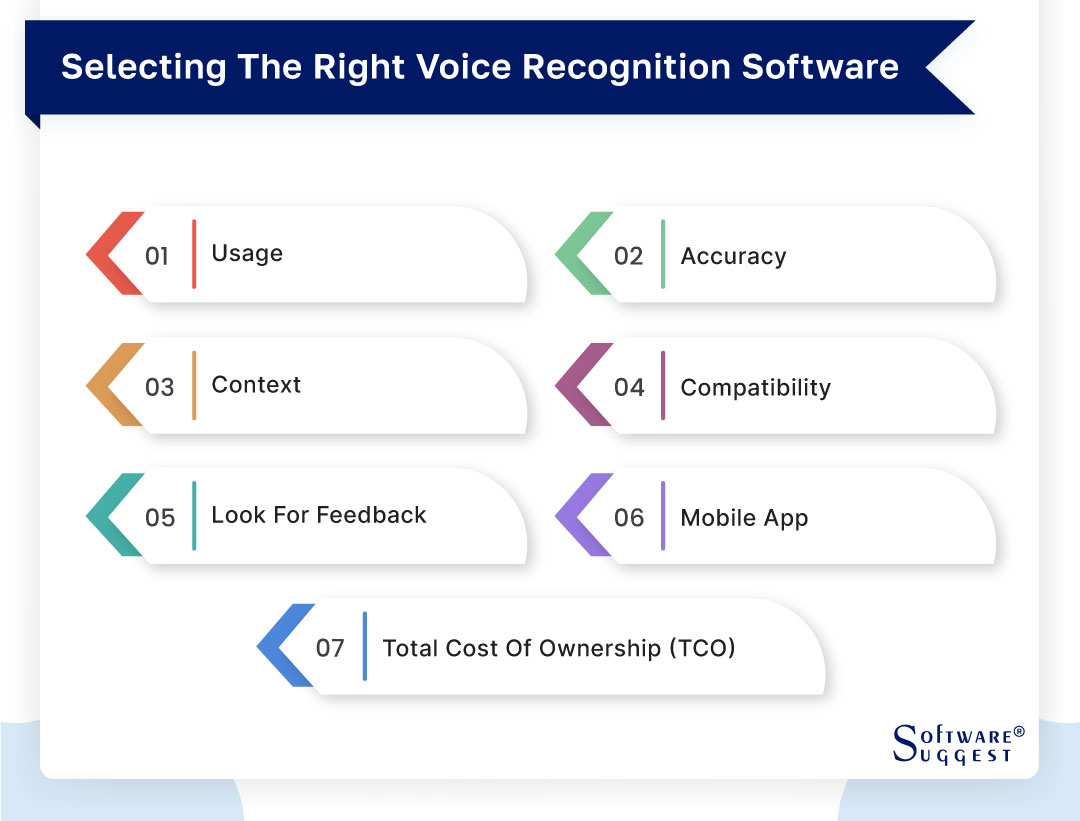
-
Usage
Consider the intended usage of the software. Determine whether it's for personal use, professional applications like transcription services, or integration into business workflows. Different software may cater to specific use cases, so understanding your requirements will help you find the most suitable option.
-
Accuracy
The accuracy of the voice recognition software is paramount. Look for tools that offer high precision in transcribing spoken language into written text. The best software often incorporates advanced AI and ML technologies to improve accuracy over time continuously.
-
Context
Choose software that can comprehend context and intent. Context-aware voice recognition ensures more meaningful interactions, allowing the software to understand commands or transcribe text more accurately based on the surrounding conversation.
-
Compatibility
Ensure the voice recognition software is compatible with your devices and operating systems. Check for cross-platform support, whether it works on Windows, macOS, iOS, Android, or web-based interfaces, to ensure seamless integration into your existing ecosystem.
-
Look for Feedback
Seek feedback and reviews from users who have already used the software. Feedback from others can provide valuable insights into the software's strengths, weaknesses, and overall performance, helping you make an informed decision.
-
Mobile App
If you require voice recognition on the go, consider software that offers a mobile app. A mobile-friendly voice recognition tool allows you to dictate or transcribe text conveniently from your smartphone or tablet.
-
Total Cost of Ownership (TCO)
Evaluate the total cost of ownership, including the upfront purchase or subscription cost and any additional charges like ongoing fees, maintenance, or support. Choose software that aligns with your budget and provides a favorable return on investment.
Top 5 Voice Recognition Tools Comparison
|
Name
|
Free Trial
|
Demo
|
Pricing
|
|---|---|---|---|
|
7 Days |
Yes |
Starting price at $8/month/seat |
|
|
7 Days |
Yes |
Starting price at $8.33/month |
|
|
14 Days |
Yes |
Pay as you Grow |
|
|
7 Days |
Yes |
On Request |
|
|
7 Days |
Yes |
Custom pricing |
Voice recognition tools, also known as speech recognition software, have become increasingly popular in recent years due to their ability to convert spoken language into text or perform various tasks based on voice commands. These tools have a wide range of applications, from dictation and transcription to virtual assistants and voice-controlled systems. Below are the 5 top Voice recognition tools.
1. Krisp
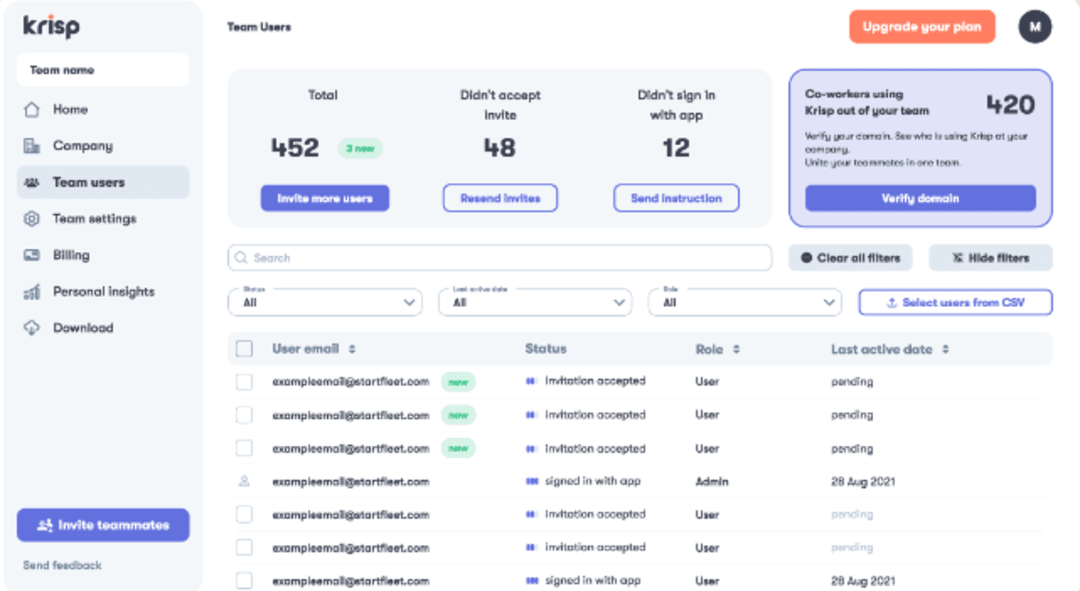
Krisp is a cutting-edge voice recognition tool designed to enhance the clarity and quality of online communication by eliminating background noise during audio calls. Using advanced machine learning algorithms, Krisp works in real-time to suppress background sounds from both ends of a conversation, ensuring user crystal-clear voice transmission.
Whether in a noisy coffee shop, bustling office, or any environment with unwanted ambient noise, Krisp can significantly improve call quality and intelligibility. It works seamlessly with popular communication platforms, such as Skype, Zoom, Microsoft Teams, and others, making it a versatile tool for professionals, remote workers, and anyone who relies on clear voice communication in their daily activities.
- Real-time noise cancellation
- Works with any app
- Cross-Platform Support
- Privacy protection
- Customizable noise filters
- Mute background noise
- Krisp significantly improves the audio quality of online calls by removing background noise, leading to clearer and more intelligible conversations.
- With background noise eliminated, users can focus better on the call's content, leading to more productive and efficient meetings.
- Krisp works with various communication platforms, making it compatible with a wide range of apps and services, including Zoom, Teams, Skype, and others.
- The effectiveness of Krisp's noise suppression can be influenced by the quality of the user's microphone and speakers.
- While Krisp offers a free version, it comes with limitations on the number of noise-free hours per week.
- Krisp's performance relies on a stable internet connection.
Pricing
- Free (For individuals): $0 USD
- Pro (For professionals and small teams): $8 USD per month / per seat
- Enterprise: On Request
2. Otter.ai

Otter.ai is a powerful voice recognition tool that leverages advanced artificial intelligence to provide real-time transcription and note-taking during meetings, lectures, interviews, and other spoken interactions. The platform excels in accurately converting spoken language into written text, making it a valuable tool for professionals, students, and anyone seeking efficient and comprehensive note-taking solutions.
With Otter.ai, users can record audio through the mobile app or integrations with communication platforms like Zoom and have it transcribed with impressive accuracy. The tool also offers features like speaker identification, keyword highlighting, and the ability to search within transcriptions, enhancing the organization and retrieval of valuable information.
- Import pre-recorded audio/video files
- Live captions for Zoom and Google Meet
- Playback control
- Search notes by keyword, speaker, date
- Sync from Zoom and Dropbox
- Share via groups and links
- Speaker name identification
- Otter Assistant for Zoom, Microsoft Teams, Google Meet
- Otter for iOS, Android, Web
- The tool provides excellent audio transcriptions.
- It helps spoken communicators assess their messages.
- Provides accurate spacing in the transcript where there are pauses in the recording.
- Sometimes the transcription will dictate the incorrect word or spelling of a word.
- It takes a while to upload the audio transcript to the website.
- There are import limitations.
Pricing
- Basic: Free
- Pro: $8.33 USD per user/month
- Business: $20 USD per user/month
- Enterprise: On Request
3. Speechmatics

Speechmatics is an advanced voice recognition tool that excels in converting spoken language into accurate and reliable written text. Using cutting-edge automatic speech recognition (ASR) technology, Speechmatics offers high-quality transcription services for various industries and applications.
With a wide range of language support, including many global languages and dialects, Speechmatics caters to a diverse user base, making it valuable for international businesses and multilingual settings. The tool's versatility allows it to be utilized in numerous scenarios, such as transcription services for meetings, conferences, interviews, customer service interactions, and more.
- Accurate transcription
- Language support
- Real-time processing
- Customizable solutions
- Speaker diarization
- Punctuation and timestamping
- Integration and API
- Speechmatics is praised for its impressive accuracy in converting spoken language into written text, making it a reliable tool for transcription services.
- The tool offers support for a wide range of languages and regional dialects, making it valuable for businesses and organizations with international operations or multilingual requirements.
- Speechmatics' cloud-based architecture enables real-time transcription, making it useful for live events, customer support interactions, and other scenarios that demand immediate voice-to-text conversion.
- Advanced voice recognition tools like Speechmatics may come with higher costs, especially for larger volumes of transcription services.
- Cloud-based processing means Speechmatics relies on a stable internet connection.
- While Speechmatics offers high accuracy, it may still encounter challenges in accurately recognizing certain accents, dialects, or specialized jargon, leading to occasional errors in transcription.
Pricing
- Pay as you Grow:
Batch (Pre-recorded)
- $0.80/hr for Standard
- $1.04/hr for Enhanced
Real-Time (Live Stream):
- $1.04/hr for Standard
- $1.35/hr for Enhanced
Premium
On Request
4. Verbio Speech Recognition

Verbio Speech Recognition is a powerful and advanced voice recognition software that excels in accurately interpreting human speech and converting it into written text. Developed by Verbio Technologies, this software utilizes cutting-edge artificial intelligence and natural language processing algorithms to achieve high accuracy and efficiency in transcription tasks.
Verbio Speech Recognition is widely used across various industries, including healthcare, legal, customer service, and more, to streamline documentation processes and enhance productivity. With its robust multi-language support and real-time processing capabilities, Verbio Speech Recognition has become a valuable tool in facilitating seamless and accessible interactions between users and technology.
- High accuracy transcription
- Advanced natural language processing (NLP)
- Real-time processing
- Multi-language support
- Speaker adaptation
- Noise Cancellation
- Vocabulary customization
- Versatile integration
- Verbio Speech Recognition is known for its excellent accuracy in transcribing spoken language into written text, making it a reliable tool for various applications.
- The software's sophisticated Natural Language Processing (NLP) algorithms enable it to understand context and intent, leading to more contextually relevant and meaningful transcriptions.
- Verbio Speech Recognition offers real-time processing, providing immediate feedback and response, enhancing user experiences, and enabling instant interactions.
- Advanced speech recognition systems like Verbio may come with higher licensing or subscription costs, which could be a barrier for smaller businesses or individual users.
- Speech recognition software can be demanding on system resources, requiring powerful hardware for optimal performance.
- Like most voice recognition systems, Verbio's accuracy may be affected by background noise, requiring users to have a quiet environment for optimal results.
Pricing
- On Request
5. Speechtexter

SpeechTexter is a highly advanced voice recognition software designed to convert spoken words into written text accurately and efficiently. Developed to facilitate various tasks, from transcription to note-taking, SpeechTexter utilizes cutting-edge natural language processing (NLP) algorithms to ensure its accuracy and user-friendliness.
- Speech-to-text conversion
- Real-time transcription
- Multi-lingual support
- Voice commands
- Cloud-based integration
- Voice training
- It minimizes the need for manual corrections.
- The platform easily caters to users from various linguistic backgrounds.
- Provides immediate feedback during dictation.
- Easily accessible to users of all skill levels.
- Limited accuracy for some accents or speech patterns, requiring occasional manual corrections.
- Internet dependency for cloud-based features, hindering functionality without an internet connection.
- Possible errors with less common languages or dialects affect accuracy in certain cases.
Pricing
- Custom pricing.
Market Trends of Voice Recognition Software
The field of Voice Recognition Software has witnessed remarkable advancements in recent years, driven by technological innovations and increasing demand for seamless human-computer interactions. As voice technology becomes more pervasive in various industries, several market trends are shaping the landscape of Voice Recognition Software. Let's explore some of the key market trends that are influencing the development and adoption of voice recognition technology -
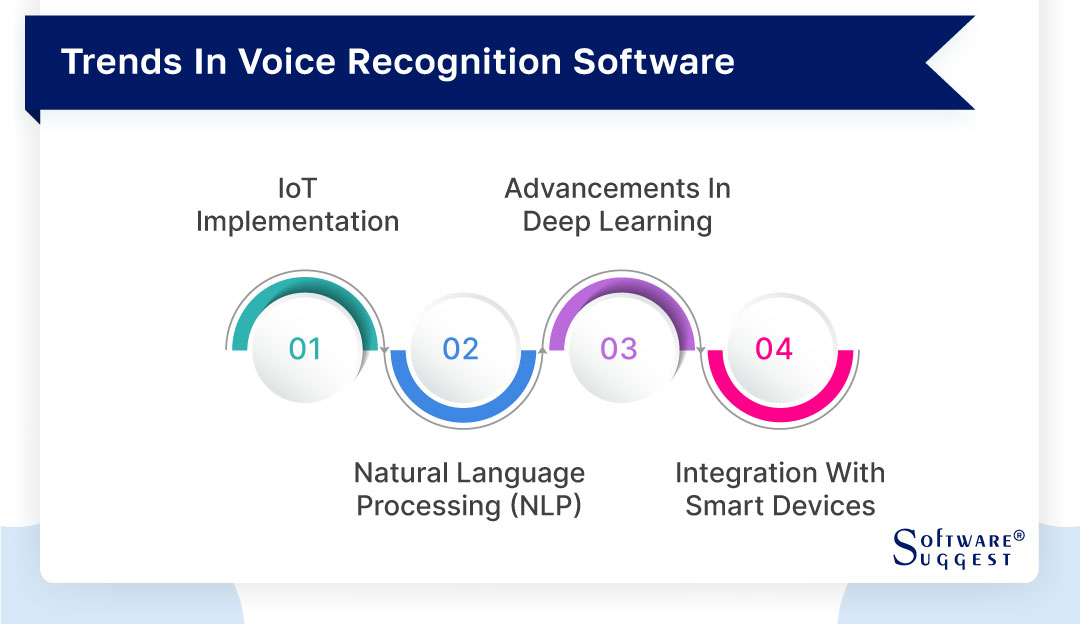
-
IoT Implementation
The integration of Voice Recognition Software with the Internet of Things (IoT) has emerged as a significant trend. Voice-enabled IoT devices, such as smart speakers, home automation systems, and wearable gadgets, have become increasingly popular. The ability to control IoT devices and access information through voice commands transforms how we interact with our surroundings, making voice recognition a crucial component of the IoT ecosystem.
-
Natural Language Processing (NLP)
Advancements in Natural Language Processing (NLP) have played a pivotal role in improving Voice Recognition Software's accuracy and contextual understanding. NLP algorithms enable the software to comprehend human language nuances, interpret intent, and respond contextually, leading to more natural and human-like interactions between users and machines.
-
Advancements in Deep Learning
Deep Learning techniques powered by Artificial Intelligence (AI), have significantly enhanced voice recognition capabilities. Sophisticated neural networks and deep learning models enable Voice Recognition Software to adapt and learn from vast amounts of data, continually improving accuracy and performance. This has led to more personalized and accurate voice interactions, even in noisy environments.
-
Integration with Smart Devices
Voice Recognition Software has become an integral part of smart devices, such as smartphones, tablets, smartwatches, and smart home appliances. The seamless integration of voice technology with these devices allows users to perform tasks hands-free, access information, and control their devices with voice commands, contributing to increased convenience and efficiency in daily life.?
Services and Software related to Voice Recognition Software
Voice Recognition Software has opened up a world of possibilities in human-computer interactions. Beyond voice-to-text conversion, several related services and software complement voice activation software, enhancing its capabilities and applications. Let's explore some of these services and software that are closely related to voice recognition technology -
-
Transcription Services
Transcription services are essential in converting spoken language into written text with high accuracy and efficiency. While Windows speech recognition software handles real-time transcription, transcription services provide professional-level transcriptions for various industries, including legal, medical, academic, and business.
These services offer human editors who carefully review and refine the transcribed text, ensuring its accuracy and meeting specific quality requirements. Transcription services are particularly beneficial for industries that demand meticulous and error-free documentation.
-
Natural Language Processing (NLP) Software
NLP software complements Voice Recognition Software by enhancing the understanding and contextual interpretation of human language. NLP algorithms enable the software to analyze and comprehend the meaning, intent, and sentiment behind spoken or written words.
This enables more sophisticated and context-aware voice interactions, making the voice recognition system capable of engaging in meaningful conversations and providing relevant responses. NLP software is employed in various applications, including chatbots, virtual assistants, sentiment analysis, and language translation.
-
Natural Language Generation (NLG) Software
While Voice Recognition Software converts spoken language to text, NLG software works in the opposite direction by generating human-like written language from structured data or data sets.
NLG software employs advanced algorithms to transform data into coherent and intelligible narratives, which can be particularly valuable in generating reports, summaries, and other written content. When combined with voice recognition, NLG can be used to convert structured data from voice commands or interactions into textual summaries or reports, enhancing communication and documentation processes.
How Much Does Voice Recognition Software Cost?
The cost of Voice Recognition Software can vary significantly depending on several factors, including the software's features, capabilities, licensing model, and intended usage. For personal use or basic voice-to-text functionality, free voice recognition apps and software are available on various platforms. These free options typically have limited features and may require an internet connection for processing.
For more advanced and professional-grade Voice Recognition Software, the cost can range from a one-time purchase fee to a monthly or yearly subscription. Some software providers offer tiered pricing plans based on usage levels or the number of users. The cost may also vary depending on whether the software is cloud-based, on-premises, or requires additional hardware integration. Generally, the cost of voice recognition software ranges between $120 to $350.
For enterprise-level solutions or industries with specialized requirements like medical or legal transcription, the cost can be higher due to the need for higher accuracy and security. Additionally, enterprise resource planning solutions may come with additional support, customization options, and data privacy compliance, which contribute to the overall cost.
Conclusion
Voice recognition software's influence on our daily lives is becoming more and more obvious as it develops. Voice recognition technology has become essential to our contemporary environment, from voice assistants in our smartphones and smart speakers to transcribing services in business settings.
As AI, NLP, and deep learning continue to progress, speech interactions will become even more precise and sophisticated. The potential for voice recognition to change sectors like healthcare, transportation, and customer service will only increase as the technology becomes more widely available. Voice Recognition Software will undoubtedly continue to play a crucial role in determining our digital future thanks to the ease of hands-free operations, greater accessibility for those with disabilities, and the promise of more context-aware interactions.









.png)










